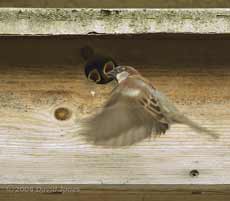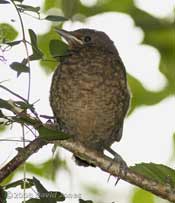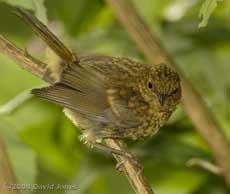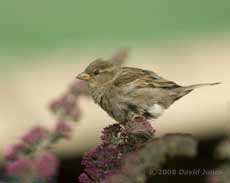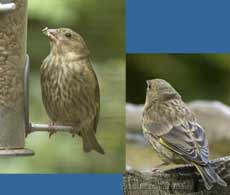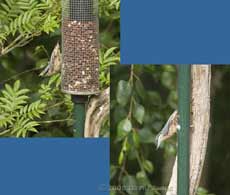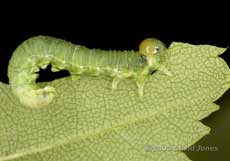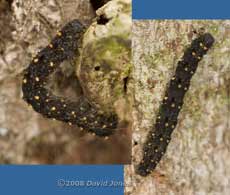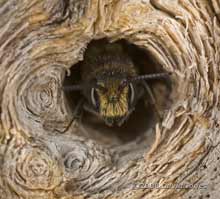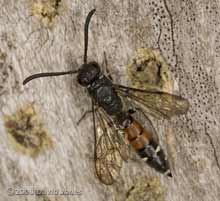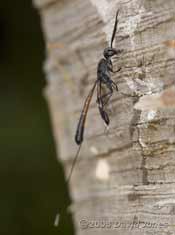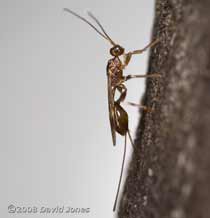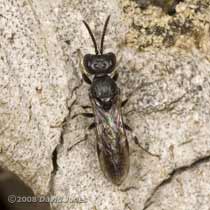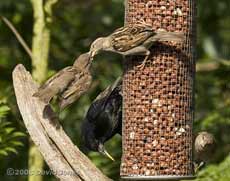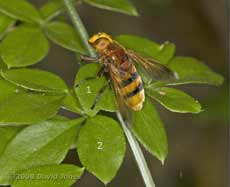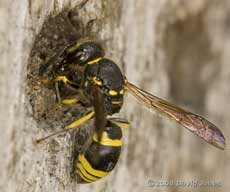Go to the last entry on this page ......Go to previous entryUp to 27 June - We are back home after another of our Cornish breaks - When we returned home we were faced with a jungle rather than a garden, thanks to ideal growing weather during our absence (warm, with decent amounts of rain, most of which missed us!). Unfortunately, my CFS has been a bit of a pain and two weeks later parts of the garden are still waiting to be tamed, I have taken only a few pictures, and have not been clear headed enough to tackle the diary - until now...... On our return, one of my first tasks was to switch on the cctv monitors to check on the nests, only to find that there had been no activity in any of them. I was surprised to see that there was no second Starling brood, and not even any signs of roosting in those boxes. The Swift boxes had not been visited, and the only visitor to the House Martin nests had been a Starling which clung briefly to the entrance of one nest as it looked in. I didn't see a Starling in the garden over the next week, and it has only been in the last few days that we have been seeing them perched on the Hawthorn again (a group of seven today), along with juveniles. There are Swifts about. I have seen up to eight in the sky over us, and they are still going into my neighbour's roof space, so I will continue to monitor the Swift boxes. As for the House Martins I am not optimistic that we will get any this year. It's not too late. After all, they didn't arrive until 10 July last year to start on their second, ill-fated brood. However, last year House Martins could be seen flying overhead in May/June. This year I only saw individual Martins on two occasions before we went away, and since our return I have had just one uncertain sighting here. There is a House Martin Survey being conducted by the British Trust for Ornithology (BTO) as part of an investigation into their status this year, with numbers down on previous years. While the camera-equipped boxes are all unoccupied at the moment there have been a young family in each of the two sets of House Sparrow boxes that we have on the house. This is the Sparrow terrace on the west-facing house wall. These chicks were still in place today, but I think that the chicks in the north-facing box may have fledged yesterday. Last week my neighbour commented on the declining Sparrow numbers. The Hawthorn is certainly a quieter place than it used to be, but hopefully the nestboxes will help to prevent us losing them completely. Away from the nest boxes, there are other young birds to be seen in the garden. The noisiest are the Goldfinch youngsters who, along with their parents are visiting the sunflower feeders every day.
We we were first home from Cornwall we noticed that the Blackbird male and female were taking food away from under the Hawthorn to a nest outside the garden. Yesterday I spotted confirmation that this time they have had a successful nesting. I was tidying up the ground under the Rowan in the late afternoon when I looked up and saw this Blackbird fledgling perched in the Birch. I didn't see it being fed but I suspect that the male adult may have fed another hidden in the Ivy.
Another successful nesting has resulted in two young Robins entertaining us whenever we sit out on our veranda. I'm tempted to say that they look nicer in this mottled plumage than when they take on their adult appearance. The pair are already competing for 'ownership' of the area around the feeders. There has been no sign of either parent coming to feed.
Both juvenile and mature Great and Blue Tits are regular visitors to the feeders, but noticeable by their absence at the moment are the Dunnocks - I've neither seen or heard any since our return. Hopefully I will get a bit more catching up done during the weekend...
29 June - A bright, dry and breezy day. I'm not going to be doing the catching up I hoped to do today, but I do want to follow up on yesterday's bird reports. While the chicks photographed yesterday are still being fed in their nestbox, there is at least one group of fledglings in the garden being fed, mainly at the bottom of the garden, perched on the branches of the Rowan and Birch trees. In the meantime, before breakfast this morning a pair of adults were taking straw into the right-hand box of the Sparrow terrace at the side of the house, so it looks as though nesting will continue there for some time to come.
Also before breakfast we had a different youngster visiting the sunflower feeders. I believe it's a young Greenfinch - there is no sign of any adults about.
Finally, a rare sighting in the garden. I was outside at just after 8.30am trying to record the sounds of an extremely vocal Starling in our Hawthorn. Amongst the noises that ruined my attempt I thought someone was tapping something with a hammer. I took the earphones off and realised that the sound was coming from the bottom of the garden. When I looked I saw a Nuthatch hammering at the peanuts in the tall feeder - the first one seen here since 6 November 2006. These are horrible pictures but at least they do record the visit. There was no sign of Blackbird juveniles here today. However, both parents have been taking food away throughout the day. I have been checking plants in the garden in the hope of finding insects to photograph but have been largely unsuccessful. Sitting outside today it was easy to see why as the Sparrows and Blue Tits scoured the undergrowth for food - hardly a plant around the pond escaped their attention.
It's almost a surprise to find sawfly larvae quite exposed on leaves of the Birch tree.
Yesterday evening I happened to check one of the bee hotels (a decaying log in contact with low vegetation) and found four of these caterpillars on the shaded side. They hadn't been there during the day, and had disappeared again by this morning.
The bee hotels are buzzing at the moment, especially the small species. It's fascinating how the level of activity varies between sunny spells and cloudy periods. When the sun shines the bees become hyperactive, and it is much easier to photograph them when the sun is hidden. This bee is waiting for the first sunshine of the morning before it leaves the hole (measuring 3mm across) it has been using as a roost. I'll try to produce a longer report on the bees in the near future.
Inevitably, their activity is attracting the attention of other species, like this female Sapyga quinquepunctatum, a parasitic wasp whose larvae are parasitic on Mason Bees,
this delicate Gasteruption jaculator which was searching for solitary bee eggs to lay its eggs beside,
and this smaller species that I haven't identified yet.
This individual was the same size as most of the small bees but when it landed on the bee hotel its behaviour had me looking closer. Whereas the bees tend not to walk around on the timber surface of the bee hotel, this ran around between holes. I believe it is a solitary wasp, possibly Crossocerus elongatulus.
I've also seen but not photographed a couple of solitary wasps with yellow-banded abdomens, and over the last two days the bee hotels have had several visits by a Ruby-tailed Wasp (Chrysis ignita). For those who haven't visited mybitoftheplanet in past years, my bee hotels are simply made up of either untreated (and well aged) sawn timber, or seasoned logs/branches into which I have drilled lots of holes. These range in diameter from the largest, at 7mm right down to 1mm, with the majority around 3mm. All sizes of holes are used by one species or another. The hotels are positioned so that they are sheltered from the worst of any rain and with most of the holes facing south to get full sunlight in the afternoons.
30 June - Another perfect summer's day, with less breeze than yesterday and so feeling warmer, although the high has been 22C on both days. I decided to set my camera up nice and early to catch the Nuthatch before breakfast. Needless to say, it didn't appear!
This activity has gone on all day, all over the garden, and there are now more fledglings to be fed as the chicks I photographed a couple of days ago left their nest this morning. This means that we now have no chicks in nests in the garden, although if yesterday's activity is anything to go by it's not the end of nesting.
I should note that next door's Swifts are still going in and out of the roof space.
It is Volucella zonaria, a hornet mimic and its larvae live as scavengers in wasps' nests. Only found in the south of England, it seems that its distribution is very localised.
In the book 'Hoverflies of Surrey' (published in 1998) Roger Morris stated that the species had been established in London since 1945 but by 1998 had hardly spread from the urban areas of the Capital (and north-east Surrey). There had been only three single sightings across other parts of the county, including one some 7km from here. Yesterday I mentioned that the bee hotels are best in a sunny spot. Amongst the first ones I installed, a couple were put into more shaded spots. One under the canopy of the Birch tree has failed completely to tend bee or wasps, and is only used by spiders (as far as I can tell). Another one is in a spot where it gets only limited exposure to sunlight.
This, with only 7mm holes has been ignored for a number of years, but this morning I found this solitary wasp busy sealing a hole, with two more freshly sealed holes just below. I think it is one of the potter wasps but so far I can't identify the species. When you click on the image you will see five large images from various angles that may help in its ID.
Late this afternoon I saw a Gasteruption jaculator egg-laying in one of the 3mm bee hotel holes. I should have marked the hole as soon as it had left, but I forgot, and now I can't remember which hole it was! As we head into July I still hope to fill in some of the gaps from this month, in particular the Lizard trip report. Click on images to see larger versions |
|
